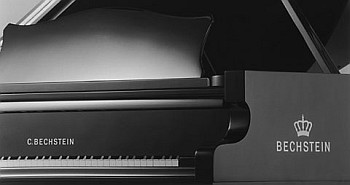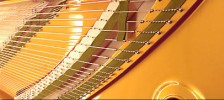C. Bechstein
Website: http://www.bechstein.com
Manufactured In: Berlin, Germany & Seifhennersdorf, Saxony, Germany

C. Bechstein is generally regarded as the premier piano of the world. Hand-crafted in Germany since 1853, this legendary instrument was the piano of choice for such illustrious pianists as Franz Liszt, Claude Debussy, Hans von Bülow, Arthur Schnabel, Krzysztof Penderecki, Witold Lutoslawski, and Leonard Bernstein. C. Bechstein manufactures pianos on the highest order of excellence, defining a new standard among the fine pianos of the world. C. Bechstein pianos are often found in great music institutions, and are demanded by discerning pianists. Prices for C. Bechstein pianos are in the upper range, but still present an excellent cost/quality ratio compared to other fine pianos. New verticals generally start at about $17,000 and up, with grands starting at about $40,000 and up.
Background
 C. Bechstein was founded in 1853 by Carl Bechstein in Berlin, Germany. Carl
Bechstein began this phenomenal achievement at the pinnacle of the Romantic period,
which flavored his perspective on piano building. His philosophy was that music
allows the emotions to free themselves, therefore the playing dynamics of a grand
piano must have a correspondingly enormous spectrum of sound expression, i.e.
dynamic possibilities. During this developmental phase, the bold visions of the
greatest composers and virtuosos combined with a piano-maker of genius, stimulating
and inspiring one another.
C. Bechstein was founded in 1853 by Carl Bechstein in Berlin, Germany. Carl
Bechstein began this phenomenal achievement at the pinnacle of the Romantic period,
which flavored his perspective on piano building. His philosophy was that music
allows the emotions to free themselves, therefore the playing dynamics of a grand
piano must have a correspondingly enormous spectrum of sound expression, i.e.
dynamic possibilities. During this developmental phase, the bold visions of the
greatest composers and virtuosos combined with a piano-maker of genius, stimulating
and inspiring one another.
In his journeyman years, Carl Bechstein had also spent time in Paris, where he got to know the secrets of the French piano making arts, and especially the developments arising from English piano mechanisms. But he also saw that his art was stagnant. He sensed the need for a resonating body which would be suitable for both gentle and robust playing. In 1853 he set up on his own in Berlin. With his ability as a piano-maker and his awareness of the signs of the times, he transformed the wishes and dreams of musicians into practice by developing the Bechstein concept for sound and technique. The pianoforte was revolutionized and perfected, and it became the most prominent means of musical expression. Important composers and virtuosos expressed their gratitude to C. Bechstein, with dedications, endorsements, and personal letters.
Strict Selection
C. Bechstein continues to use a large amount of natural materials. Strict quality standards require suitability tests and preliminary selection. Nothing is left to chance: Be it the resilience of a layer of felt, the suppleness of a consignment of leather, or the consistent grain of a veneer surface. Ecological criteria also play an important role. In particular, the hammerheads, which are decisive for the formation of sound, are governed by the strictest criteria. The wool quality in the tumbled felt coating and the characteristics of the leather are formed through the living conditions of their "four-legged suppliers." Even an incorrect tanning additive could ruin a leather coating for use in the wear-intensive piano keyboard-and-action mechanism. If the finding of the numerous intermediate tests reveal that, say, a set of hammerheads does not meet the highest standards, then it is replaced. Only the best is good enough for C. Bechstein.
Wood Quality: The Basis of Longevity
 Each type of wood is used in accordance to its function and with the latest
ecological information. Consistent care, drying, treatment and storage form the
basis of a stability that holds for generations. The wood used for C. Bechstein
grand and upright pianos is selected on the basis of important criteria for sound,
stability, and durability. The exceptional quality of the C. Bechstein sound and
playing experience can be traced back to this very conscious selection with regard
to the relevant function in the sound body and in the action assembly. Layered,
laminated hard wood for the inner grand piano rim and the pin block; rim posts
made of stable sound-supporting pine; the finest mountain spruce for the soundboard;
high-quality core woods for the piano cabinet; these components adhere to the
highest sound and touch requirements. On account of its ideal characteristics,
we use only spruce wood grown in certain regions for the soundboard. The structure
of the annual rings of growth reflects the growing process of the tree, from which
our experts can deduce the sound potential of every single board used. Because of
its optimal load-bearing capacity and sound supportiveness, we select pine and
hard wood for the vertical back, i.e. the grand piano rim and post structures.
Each type of wood is used in accordance to its function and with the latest
ecological information. Consistent care, drying, treatment and storage form the
basis of a stability that holds for generations. The wood used for C. Bechstein
grand and upright pianos is selected on the basis of important criteria for sound,
stability, and durability. The exceptional quality of the C. Bechstein sound and
playing experience can be traced back to this very conscious selection with regard
to the relevant function in the sound body and in the action assembly. Layered,
laminated hard wood for the inner grand piano rim and the pin block; rim posts
made of stable sound-supporting pine; the finest mountain spruce for the soundboard;
high-quality core woods for the piano cabinet; these components adhere to the
highest sound and touch requirements. On account of its ideal characteristics,
we use only spruce wood grown in certain regions for the soundboard. The structure
of the annual rings of growth reflects the growing process of the tree, from which
our experts can deduce the sound potential of every single board used. Because of
its optimal load-bearing capacity and sound supportiveness, we select pine and
hard wood for the vertical back, i.e. the grand piano rim and post structures.
Sumptuous Veneers
Valuable veneers are joined together sheet by sheet, and laminated to the cabinet core board in layers of 0.7mm thick. Subsequent moistening opens the pores of the wood in preparation for a very fine sanding. Depending on the surface design, a staining or varnishing process follows. People are sensitive to naturalness. The individual surface structure and grain of a selected wood, for example, is convincing not only to the eye, but also to the feel of the hand. Veneers are available in: Alder, Beech, Cherry, Mahogany, Walnut, Oak, Polished Ebony, Polished White, Bubinga, Madrona Burl, Moabi, Myrtie Burl, Pommele, Pyramid Mahogany, Santos Rosewood, Vavona Burled, Walnut Burled.
The Cabinet
C. Bechstein works in accordance with an integral design principle. All the components, the cabinet included, are designed to have a sound-supporting effect. The top of the range vertical piano models have cabinets made of cabinet makers core board which is known as sound enhancing, a very special, valuable material that particularly supports the unfolding of the sound.
The C. Bechstein Resonance Body: The Very Soul of Sound
The manufacture of the resonance body is a central element in grand and upright
piano-making of the highest standard. The C. Bechstein resonance body system begins
with a very special wood membrane. Bit by bit, it is tested with respect to its
 special sound characteristics, its length of vibration and its behavior during
vibration. Each board has its own unique characteristics, which our technical
experts evaluate and take into account. Special drying, storage and acclimatizing
protect it from future fluctuations in temperature and climate. The highly sensitive,
tension-loaded C. Bechstein resonance membrane is glued to the inner-rim. C.
Bechstein employs technology which is able to define and adhere to the most precise
specifications for the tension relationships at each point of the sound body and
individualized for each specific model. With a precision of 1/100 mm tolerance,
the inner rim is optimally formed to the tension relationships of the soundboard
in question. C. Bechstein's optimal freedom of vibration enables the sound to
unfold with maximal conservation of energy- a qualitative advantage you can hear.
The color and character of the sound are influenced by the size and diameters
specific to the model in question. Even the diameter of the C. Bechstein soundboard
is formed precisely during the process, thereby varying in diameter. The size of
the soundboard specific to the model is also influenced by the optimization of a
room's potential. C. Bechstein vertical pianos additionally have what are known
as sound board corner resonators, which optimize the timbre and the volume of
the sound.
special sound characteristics, its length of vibration and its behavior during
vibration. Each board has its own unique characteristics, which our technical
experts evaluate and take into account. Special drying, storage and acclimatizing
protect it from future fluctuations in temperature and climate. The highly sensitive,
tension-loaded C. Bechstein resonance membrane is glued to the inner-rim. C.
Bechstein employs technology which is able to define and adhere to the most precise
specifications for the tension relationships at each point of the sound body and
individualized for each specific model. With a precision of 1/100 mm tolerance,
the inner rim is optimally formed to the tension relationships of the soundboard
in question. C. Bechstein's optimal freedom of vibration enables the sound to
unfold with maximal conservation of energy- a qualitative advantage you can hear.
The color and character of the sound are influenced by the size and diameters
specific to the model in question. Even the diameter of the C. Bechstein soundboard
is formed precisely during the process, thereby varying in diameter. The size of
the soundboard specific to the model is also influenced by the optimization of a
room's potential. C. Bechstein vertical pianos additionally have what are known
as sound board corner resonators, which optimize the timbre and the volume of
the sound.
Bridges Made of Solid and Laminated Hardwood

Bridges connect the strings and the board. The bridge pressure, which is the transfer factor for the string vibration on the board, is re-specified for each individual instrument, depending on the actual engineering and flexibility of the board. The form, dimensions and position of the bridges in relation to the soundboard curvature ensure optimal sound transfer. The integral working procedure at C. Bechstein takes all these individual finer details into account. There in no generalized treatment in the manufacture of C. Bechstein pianos.
The Soundboard Rims
Another essential element of the C. Bechstein soundboard system, the ribs maintain the form of the soundboard and support the distribution of the sound energy. At C. Bechstein, the endpoints of the ribs are inserted into custom-made pockets, so that the board tension is not reduced over time. These "rib pockets" precisely match the ends of the ribs and their diameter. The curves and tensions in the board and the ribs react in ideal harmony with the changes of room temperature and humidity. When the instrument is played, the soundboard can even react sensitively to minimal vibrations. The piano engineering is sensational - and is even applied to C. Bechstein upright pianos.
The Pin Bloc - a Warranting Factor for Optimal Tuning Stability
C. Bechstein pin blocks are multi-layered, guaranteeing excellent hold and optimal torsion of the tuning pin torque - resulting in very good tuning of the piano. Copper beech, the most ideal hardwood, is cross laminated to provide strong resistance so that the tuning pin holds for life. C. Bechstein grand and upright pianos are known for their tuning stability, which they can prove impressively in concerts with extreme virtuoso programs and pianists.
Back and Rim
The C. Bechstein hard pine wood vertical back structure gets its stability from the excellent engineering, the material and the treatment process. This solid wooden frame supports the entire weight of the board, the cast iron plate, and the action assembly. For grand pianos, C. Bechstein uses an arrangement of the solid wood laminated beam structure worked out specifically for each model. Density and resilience of materials are selected with regard to the sound properties and the finer aspects of playing. Every detail supports the function of the instrument. Every beam of the grand piano rim is embedded in the rim itself with a precision of 0.01mm and anchored with wooden dowels. In the C. Bechstein upright piano, the impressive solid back ensures both a dynamic range of tone as well as excellent tuning stability. The highest levels of stability and durability over generations are thereby guaranteed.
The Grand Piano Lid
Here you have intricate quality workmanship hidden beneath a brilliant surface. Solid pieces of wood are laminated together, and are then "sealed" in a special process of veneers. This is the core element of our torsion-resistant lid design. Subsequently, further laminated layers of wood beneath the topmost precious wood covering are veneered together a number of times in specific wood fiber directions. Such an elaborately crafted lid adds to the projection of the sound without being too heavy to handle.

The Lyre and the Grand Piano Legs
The movement of a heavyweight grand piano on stage is safeguarded for C. Bechstein by means of special "catches" for the piano legs. C. Bechstein also ensures easy, foot-friendly usage of the pedals - a sensitive aspect when making music. The pedal levers are engineered for precision of pedal usage. After all, a lot of tone color is influenced - on a fine piano - by pedal usage.
Cast Iron Plates (Frames)
The iron plate in a C. Bechstein, which has to withstand the pull of the strings, is made from high quality grey iron in a sand casting process. This traditional technique, whereby the liquid iron flows into a damp bed of sand, has a distinct advantage over the vacuum process, particularly as regards to the overall sound considerations. The dimensions and the stress distribution of the cast iron plate in relation to the sound body is decisive for the circulation of the energy in the upright or grand piano, since as much as 18 to 20 tons of tractive power must be borne by the plate in combination with the vertical back or grand rim. This plate, designed to meet the highest requirements in absolute durability and stability, takes into account in its static calculations the mass and resistance to pressure. As to aesthetics, the plate undergoes many surface treatments and emerges as a bronze-colored gem of the instrument.
The Action and the Hammerheads
 Each Bechstein piano, upright or grand has a Renner action, an excellent piece of
German engineering. The specification of each action is defined by the Bechstein
master piano makers.
Each Bechstein piano, upright or grand has a Renner action, an excellent piece of
German engineering. The specification of each action is defined by the Bechstein
master piano makers.
The hammerheads are made specifically and individually for each model.
Bechstein masters make the choice of the required tension within the hammer felt,
the density of the wooded core of the hammerhead, the choice of the wool and shape
of the wooden core are defined by Bechstein. The position of the boring on the
hammerhead core and glue-joint of the hammershank, its shape and material as well
as the position of its pin in relation to all the other levers of the action are
an integral part of Bechstein action engineering. The back check, the hammer shank
roller and the position of the let-off screw are defined by the Bechstein piano
making masters. Due to these choices, the Bechstein touch is precise from ppp to
fff. The hammer head is voiced over a number of sessions within the manufacturing
process, a total voicing job lasts up to three days. Just as piano playing is an
art, so is the voicing. The one allows for the other.
The Strings and the Tone Color

The balance of Bechstein piano strings in their relationship to one another, the specific and highlighted partial tones and the perfect interaction between strings, bridge and soundboard with its ribs clearly influences the tone character. When piano string scales are designed perfectly, they are certain to be boring. As early as the high period of Hellenistic culture it was known that perfect symmetry is boring to the mind. Bechstein scale designs are known to be the best in the piano industry, especially famous for their clarity and richness in color of tone. Rather than being perfect, they are colorful.
Richness of Color and Sound Volume
"A C. Bechstein piano sounds the way I want it to, as though automatically" - this is often said. A secret of the convincing beauty of the sound of the C. Bechstein instruments lies in their optimal realization of the individual sound conception of a player. This is brought about by the closely guarded secrets in the soundboard and rim design, the general coherence of all the details, the individual and excellent work processes under manufacturing conditions, because almost all the components of the instrument have an influence on the quality and the projection of the sound. The fine, sensitive end result stems from a unique recipe.
Pickle Piano Company
104 West Lake Street
Bloomingdale, IL 60108
Telephone: 630-894-2992
Fax: 630-894-2743
E-mail: questions@picklepiano.com
Site Map
